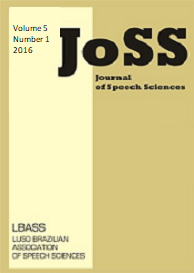Abstract
We start from the proposal of Fodor (2002) that both syntactic structures as the prosodic are computed during silent reading. We examined the effect of prosodic marking graphical processing of silent reading of temporary ambiguous sentences as: When dogs attacked / a girl (,) / tore her dress / yellow, considering the integration syntax-prosody. We compare the silent reading time of the third fragment of temporary subordinate ambiguous sentences in written texts of the Portuguese language for deaf bilingual Libras/Portuguese. We assume that deaf people spend more time reading than listeners, but there would also be a difference as one disambiguator comma were or not present in the sentence. The experiment made up an online test of 108 subordinate temporary ambiguous sentences, in 6 conditions, through DMDX program. 18 deaf bilingual Libras/Portuguese and 18 listeners participated. There was no significant difference in the reading time of the third fragment of temporary subordinate ambiguous sentences between deaf and listeners; also, there was no significant difference with the use of the comma. There were differences between the means Late Closure (LC) and Early Closure (EC); Semantic Control (SC) and Early Closure (EC). There was no significant difference between the types of Late Closure (LC) and Semantic Coutrol (SC) sentence.References
BARBOSA, M. G. S.; BARBOSA, V. S.Análise da produção escrita dos surdos: a interferência da Língua Brasileira de Sinais.V Colóquio Internacional: Educação e Contemporaneidade.São Cristovão-SE, 2011.
CAPOVILLA, F. C.; RAPHAEL, W. D.; MAURICIO, A. C. Novo Deit-Libras: Dicionário Enciclopédico Ilustrado Trilíngue da Língua de Sinais Brasileira (Libras) baseado em Linguística e Neurociências Cognitivas. 2 ed. rev. e ampl. São Paulo: Editora da Universidade de São Paulo: Inep: CNPq: Capes: Obeduc, 2012. Vol. 1. Parte 1: Sign Writting: como escrever a articulação visível dos sinais da Libras, p. 168-171.
EDWARDS, J. (2013). Bilingualism and multilingualism: some central concepts. In: T. Bhatia & W. Ritchie (Eds.), The Handbook of Bilingualism – 2nd Edition. Malden, MA: Willey-Blackwell, 2013, p.5-25.
EFROYMSON, M.A. Multiple regression analysis.Mathematical Methods for Digital Computers, 1960. EMMOREY, K.; BORINSTEIN, H. B.; THOMPSON, R.; GOLLAN, T. H. Bimodal bilingualism.Bilingualism: Language and Cognition, vol. 11, n. 01, p. 43 – 61, mar. 2008.
FERNANDES, S. Educação de Surdos. 2.ed.atual. Curitiba: Ibpex, 2011.
FITZMAURICE, G.M; LAIRD, N.M; WARE, J.H. Applied Longitudinal Analysis. New Jersey: John Wiley & Sons, 2011.
FODOR, J.D. Psycholinguistics cannot escape prosody. Proceedings of Speech Prosody 2008, Aix-enProvence, France. 2002.
FONSECA, A. A. prosódia no parsing: evidências experimentais do acesso à informação prosódica no input linguístico. Belo Horizonte: UFMG. Tese de Doutorado. 2012.
FRAZIER, L. On Comprehending Sentences: Syntactic parsing strategies. Ph.D. Dissertation, University of Connecticut, 1979.
GROSJEAN, F. (1992) The bilingual and the bicultural person in the hearing and in the deaf world.Sign Language Studies, vol. 77, p. 307–320, 1992.
GROSJEAN, F. Bilingualism: A Short Introduction. In: GROSJEAN, F.; LI, P. (eds). The Psycholinguistics of Bilingualism. Malden, MA: Willey-Blackwell, Inc., 2013. p. 5-25.
GROSJEAN, F. Studying Bilinguals. New York: Oxford University Press, 2008.
GROSJEAN, F. Studying bilinguals: Metodological and conceptual issues. Bilingualism: Language and Cognition, p. 131-149, 1998.
LIANG, K.Y; ZEGER; S.L. Longitudinal Data Analysis using generalized linear models. Biometrika,1986.
MACKEY, W. F. The description of bilingualism. In: WEI, L. (Ed.). The Bilingualism Reader. London: Routledge, 2000. p. 22-52.
MCCULLAGH, P; NELDER; J.A. Generalized Linear Models. London : Chapman and Hall, 1989.
QUADROS. R. et al. Exame ProLibras. Florianópolis, 2009.
RIBEIRO, A. J.C. LATE CLOSURE em parsing no Português do Brasil. Rio de Janeiro: UFRJ. Tese de Doutorado. 2004.

This work is licensed under a Creative Commons Attribution 4.0 International License.
Copyright (c) 2016 José Olímpio de Magalhães, Guilherme Lourenço, Francisca Maria Carvalho, Giselli Mara da Silva

